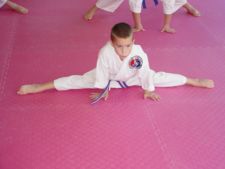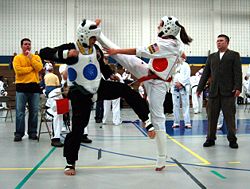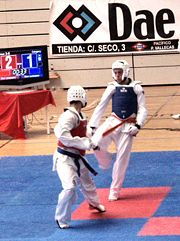Taekwondo
2008/9 Schools Wikipedia Selection. Related subjects: Sports
 |
|
| Taekwondo | |
|---|---|
 A WTF taekwondo sparring match |
|
| Also known as | Taekwon-Do, Tae Kwon-Do, Tae Kwon Do |
| Focus | Striking |
| Country of origin | |
| Olympic Sport | Since 2000 ( WTF regulations) |
| Taekwondo | ||||||||
|---|---|---|---|---|---|---|---|---|
|
Taekwondo IPA: /tаɪkwɒndoʊ/) is a Korean martial art and combat sport. Taekwondo is the national sport of South Korea and sparring, kyeorugi, is an Olympic sporting event. In Korean hanja, tae (跆) means to destroy with the feet; kwon (拳) means "fist"; and do (道) means "path" or "way". Hence, taekwondo is loosely translated as "the way of the foot and fist".
Taekwondo's popularity has resulted in the divergent evolution of the martial art. As with many other martial arts, taekwondo is a combination of combat techniques, self-defense, sport, exercise, and philosophy.
Although there are great doctrinal and technical differences among taekwondo organizations, the art in general emphasizes kicks thrown from a mobile stance, using the leg's greater reach and power to disable the opponent from a distance. In sparring, turning, front, reverse turning, and side kicks are often used, as well as the backfist and reverse punch; advanced kicks include jumping, spinning, sliding, and skipping kicks, often in combination. Taekwondo training generally includes a system of blocks, punches, and open-handed strikes and may also include various take-downs or sweeps, throws, and joint locks.
History
The oldest Korean martial art was an amalgamation of unarmed combat styles developed by the three rival Korean kingdoms of Goguryeo, Silla and Baekje. Young men were trained in unarmed combat techniques to develop strength, speed, and survival skills. The most popular of these techniques was subak, with taekkyeon being the most popular of the segments of subak.
As the Goguryeo kingdom grew in power, the neighboring Silla kingdom became comparatively weaker, and an effort was undertaken among the Silla to develop a corps of special warriors. The Silla had a regular army but its military training techniques were less advanced than those of the Goguryeo, and its soldiers were generally of a lesser caliber. The Silla selected young men, some as young as twelve, and trained them in the liberal arts. Those who demonstrated strong natural aptitude were selected as trainees in the new special warrior corps, called the Hwarang. It was believed that young men with a talent for the liberal arts may have the grace to become competent warriors. These warriors were instructed in academics as well as martial arts, learning philosophy, history, a code of ethics, and equestrian sports. Their military training included an extensive weapons program involving swordsmanship and archery, both on horseback and on foot, as well as lessons in military tactics and unarmed combat using subak. Although subak was a leg-oriented art in Goguryeo, Silla's influence added hand techniques to the practice of subak.
In spite of Korea's rich history of ancient and traditional martial arts, Korean martial arts faded into obscurity during the Joseon Dynasty. Korean society became highly centralized under Korean Confucianism and martial arts were lowly regarded in a society whose ideals were epitomized by its scholar-kings. Formal practices of traditional martial arts such as subak and taekkyeon were reserved for sanctioned military uses. However folk practice of taekkyeon as a kicking game still persisted into the 19th century.
Modern Taekwondo
During the Japanese occupation (1910-1945), the practice of taekkyeon was banned. Although the art essentially vanished, some aspects of taekkyeon may have survived through underground teaching and folk custom. As the Japanese colonization established a firm foothold in Korea, the few Koreans who were able to attend Japanese universities were exposed to Okinawan and Japanese martial arts, and some received black belts in these arts. Koreans in China were also exposed to Chinese martial arts.
After World War II and the liberation of Korea, several Kwans (schools) arose. They included: Chung Do Kwan, Moo Duk Kwan, Jidokwan (or Yun Moo Kwan), Chang Moo Kwan, Han Moo Kwan, Oh Do Kwan, Jung Do Kwan, Kang Duk Won, and Song Moo Kwan. All taught Japanese-influenced systems. Most were based on Japanese Karate, most notabaly Shotokan Karate. As these arts began to be taught openly by Koreans who had learned it in Japan, they were taught under such names as kongsudo and tangsudo. According to Steven D. Capener:
This process of development can be broadly outlined as follows: Japanese karate called kongsudo or tangsudo was introduced to Korea just after liberation from Japan by Koreans who had learned karate in Japan. Upon returning, these Koreans opened karate gymnasiums promoting what they were teaching as karate, much like the process followed by the early Judo instructors. Well after these schools became established, the need to "Koreanize" was felt. The process of Koreanization consisted of three main aspects. The first was the selection of a new, non-Japanese name. The second was the creation of a system of techniques and training which was distinctly different from that of karate, and the third was the attempt to establish t'aegwondo's existence and development within the historical flow of Korean civilization.
The liberation of Korea also brought renewed interest in indigenous arts. Song Duk-ki gave a taekkyon demonstration for Republic of Korea President Syngman Rhee. Korean nationalism led to the development of a new, clearly Korean art from the Japanese Karate base, influenced by memories of past Korean martial arts and by a desire to create an art that could be practiced as a competitive sport.,
By the end of the Korean War, nine schools of martial arts had emerged, and South Korean President Syngman Rhee ordered that the various schools unify under a single system. A governmental body selected a naming committee's submission of "tae-kwon-do". Following the submission of the name "taekwondo" on April 11, 1955 by General Choi Hong Hi, the name was unanimously accepted. the Korean Taekwondo Association (KTA) was formed in 1959 to facilitate the unification. Shortly thereafter, taekwondo made its debut worldwide. Standardization efforts in South Korea stalled, as the kwans continued to teach differing styles. Another request from the Korean government for unification resulted in the formation of the Korea Tae Soo Do Association, which changed its name back to the Korean Taekwondo Association in 1965 following a change of leadership.
General Choi Hong Hi was the author of the first English taekwondo syllabus book, entitled "Taekwon-Do" and published by Daeha Publication Company in 1965 . General Choi later founded the International Taekwondo Federation (ITF) on March 22nd 1966 in Seoul, South Korea. Choi had studied Korean martial arts when young and earned a black belt in Shotokan karate in Japan. Subsequently, Choi fell out of favour with the authorities in South Korea and moved his organization to Canada in 1972. It is also worth noting that he is regarded by ITF taekwondo practitioners as the founder of taekwondo.
In 1972, the Korea Taekwondo Association Central Dojang was opened. A few months later, the name was changed to the Kukkiwon. The following year, the World Taekwondo Federation was formed. The International Olympic Committee recognized the WTF and taekwondo sparring in 1980, and the sport was accepted as a demonstration event at the 1988 Seoul and the 1992 Barcelona Summer Olympic Games. It became an official medal event as of the 2000 Sydney Olympic Games. Taekwondo is one of two Asian martial arts (judo being the other) in the Olympic Games.
The WTF operates internationally, and taekwondo is one of the most popular martial arts in the world. Although competition has always been a significant feature of taekwondo, many practitioners study taekwondo for personal development, to learn self-defense, or for a combination of reasons.
Organizations
The largest taekwondo organizations are the World Taekwondo Federation (WTF) and International Taekwondo Federation (ITF). The WTF is headquartered in South Korea and was founded in 1973 by a group of various national taekwondo teams. Its purpose is to coordinate international competition events under the rules of the International Olympic Committee (IOC).
Although the terms "WTF" and "Kukkiwon" are often mistakenly used interchangeably to refer to this organization, the Kukkiwon is a completely different organization which trains and certifies instructors and issues official dan and pum certificates worldwide. The Kukkiwon has its own unique physical building that contains the administrative offices of Kukkiwon (World Taekwondo Headquarters) in Seoul, South Korea. The Kukkiwon was founded in 1972.
The unofficial training headquarters of the International Taekwondo Federation is located at the Taekwondo Palace located in Pyongyang, North Korea and was founded in the mid-1990s. Today, the International Taekwondo Federation is splintered into three different groups, all claiming to be the original. The three are located in Austria, Canada and North Korea.
Aside from the World Taekwondo Federation and the International Taekwondo Federation, there are many other organizations. These include the American Taekwondo Federation (ATF), the American Taekwondo Association (ATA), the International Progressive Taekwondo Federation (IPTF), the Taekwondo Association of Great Britain (TAGB), and so on. These private organizations require that students belong to a member club or school. Events and competitions held by private organizations are mostly closed to other Taekwondo students. However, the WTF-sanctioned events allow any person, regardless of school affiliation or martial arts style, to compete in World Taekwondo Federation events as long as he or she is a member of the WTF Member National Association in his or her nation, which is open to anyone to join. The major technical differences among these many organizations revolve around the patterns, called hyeong 형, pumsae 품새, or teul 틀, sets of prescribed formal sequences of movements that demonstrate mastery of posture, positioning, and technique, sparring rules for competition (e.g. ITF light-contact versus WTF full-contact), and philosophy.
In addition to these private organizations, the original schools ( kwans) that formed the organization that would eventually become the Kukkiwon continue to exist as independent fraternal membership organizations that support the WTF and the Kukkiwon. The official curriculum of the kwans is that of the Kukkiwon. The kwans also function as a channel for the issuing of Kukkiwon dan and pum certification (black belt ranks) for their members. Each kwan has its own individual pledge of tenets and manners that describes the organization's goals for personal improvement. For example, the tenets of Oh Do Kwan and the ITF are: courtesy (ye-ui 예의), integrity (yom-chi 염치), perseverance (in-nae 인내), self-control (geuk-gi 극기), and indomitable spirit (baek-jeol-bul-gul 백절불굴). The Jidokwan manners are: view, feel, think, speak, order, contribute, have ability, and conduct rightly.
Some organizations also recognize one or two additional tenets beyond the five original Oh Do Kwan tenets; these are community service (sa-hui-bong-sa 사회봉사) and love (sa-rang 사랑).
Features
Taekwondo is famed for its use of kicking techniques, which distinguishes it from martial arts such as karate or southern styles of kung fu. The rationale is that the leg is the longest and strongest weapon a martial artist has, and kicks thus have the greatest potential to execute powerful strikes without successful retaliation.
Taekwondo as a sport and exercise is popular with people of both sexes and of many ages. Physically, taekwondo develops strength, speed, balance, flexibility, and stamina. An example of the union of mental and physical discipline is the breaking of boards, which requires both physical mastery of the technique and the concentration to focus one's strength.
A taekwondo student typically wears a uniform (dobok 도복), often white but sometimes black or other colors, with a belt (tti 띠) tied around the waist. The belt indicates the student's rank. The school or place where instruction is given is called the dojang 도장.
Although each taekwondo club or school will be different, a taekwondo student can typically expect to take part in most or all of the following:
- Learning the techniques and curriculum of taekwondo
- Both anaerobic and aerobic workout, including stretching
- Self-defense techniques (hosinsul 호신술)
- Patterns (also called forms, pumse 품새, teul 틀, hyeong 형)
- Sparring (called kyeorugi 겨루기, or matseogi 맞서기 in the ITF), which may include 3-, 2- and 1-step sparring, free-style, arranged, and point sparring, and other types
- Relaxation and meditation exercises
- Falling techniques
- Breaking (using techniques to break boards for testing, training and martial arts demonstrations)
- Exams to progress to the next rank
- A focus on mental and ethical discipline, justice, etiquette, respect, and self-confidence
Some taekwondo instructors also incorporate the use of pressure points, known as ji ap sul as well as grabbing self-defense techniques borrowed from other martial arts, such as Hapkido and Judo.
Ranks, belts, and promotion
Taekwondo ranks are separated into "junior" and "senior" or "student" and "instructor" sections. The junior section typically consists of ten ranks indicated by the Korean word geup 급 (also Romanized as gup or kup). The junior ranks are usually identified by belts of various colors, depending on the school, so these ranks are sometimes called "colour belts". Geup rank may be indicated by stripes on belts rather than by colored belts. Students begin at tenth geup (usually indicated by a white belt) and advance toward first geup.
The senior section is made up nine full ranks of black belt along with an honorary tenth degree which you can be voted into after your death. Each rank known by the Korean word dan 단, also referred to as "black belts" and "degrees" (as in "third dan" or "third-degree black belt"). Black belts begin at first degree and advance to second, third, and so on. The degree is often indicated on the belt itself with stripes, Roman numerals, or other methods; but sometimes black belts are plain and unadorned regardless of rank.
To advance from one rank to the next, students typically complete promotion tests in which they demonstrate their proficiency in the various aspects of the art before a panel of judges. Promotion tests vary from school to school, but may include such elements as the execution of patterns, which combine various techniques in specific sequences; the breaking of boards, to demonstrate the ability to use techniques with both power and control; sparring and self-defense, to demonstrate the practical application and control of techniques; and answering questions on terminology, concepts, history, and so on, to demonstrate knowledge and understanding of the art. Students are sometimes required to take a written test or to submit a research paper in addition to taking the practical test.
Promotion from one geup to the next can proceed fairly rapidly, since schools often allow geup promotions every two, three, or four months. Students of geup rank learn the most basic techniques first, then move on to more advanced techniques as they approach first dan.
In contrast, promotion from one dan to the next can take years. The general rule is that a black belt may advance from one rank to the next only after the number of years equivalent to the rank. For example, a newly-promoted third-degree black belt may not be allowed to promote to fourth-degree until three years have passed. Some organizations also have age requirements related to dan promotions, and may grant younger students pum 품 (junior black belt) ranks rather than dan ranks until they reach a certain age. Dan ranks usually have titles associated with them, such as "master" and "instructor". However, these titles and their associations with specific ranks vary among schools and organizations.
The two main Taekwondo organizations have their own rules and standards when it comes to ranks and the titles that go with them; for details, see Kukkiwon and International Taekwondo Federation.
Competition
Taekwondo competition typically involves sparring, breaking, patterns, and/or self-defense (hosinsul). However, in Olympic taekwondo competition, only sparring is contested; and in Olympic sparring the WTF competition rules are used. These rules are available at the WTF website.
Under WTF and Olympic rules, sparring takes place between two competitors in an area measuring 10 meters square. Each match or bout consists of three non-stop rounds of contact with rest between rounds. Colored belts fight in 1-minute rounds with a 30-second break, while black belts fight in 2-minute rounds with 1-minute breaks. Points are awarded for permitted, accurate, and powerful techniques to the legal scoring areas; light contact to a scoring area does not score any points. A kick or punch that makes contact with the opponent's hogu (a trunk protector that functions as a scoring target) scores one point; a kick to the head scores two points. Punches to the head are not allowed. If a competitor is knocked down by a scoring technique and the referee counts, then an additional point is awarded to the opponent.
At the end of three rounds, the competitor with the most points wins the match. If, during the match, one competitor gains a 7-point lead over the other, or if one competitor reaches a total of 12 points, then that competitor is immediately declared the winner and the match ends. In the event of a tie at the end of three rounds, a fourth "sudden death" overtime round will be held to determine the winner, after a 1-minute rest period.
The ITF sparring rules are similar, but differ from the WTF rules in several respects. For example, hand attacks to the head are allowed; flying techniques score more points than grounded techniques; the competition area is slightly smaller (9 meters square instead of 10 meters); and competitors do not wear the hogu used in Olympic-style sparring (although they are required to wear approved foot and hand protection equipment). The ITF competition rules and regulations are available at the ITF information website.
Korean commands
In taekwondo, Korean language commands are often used. For words used in counting, see Korean numerals.
| Word | Hangeul | Meaning |
|---|---|---|
| Charyeot | 차렷 | Attention |
| Gyeongnye | 경례 | Bow |
| Baro | 바로 | Return |
| Swieo | 쉬어 | At ease, relax |
| Kihap | 기합 | Yell |
| Junbi | 준비 | Ready |
| Sijak | 시작 | Begin |
| Gallyeo | 갈려 | Break (separate) |
| Gyesok | 계속 | Continue |
| Geuman | 그만 | Finish (stop) |
| Dwiro dora | 뒤로 돌아 | Turn around (about turn) |
| Haesan | 해산 | Dismiss |





